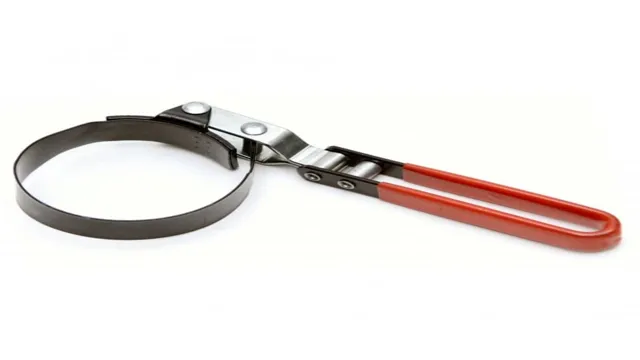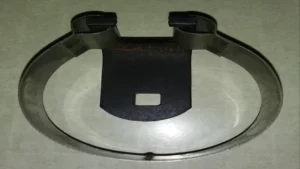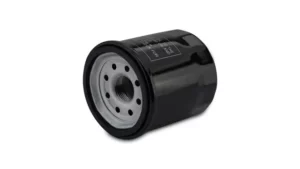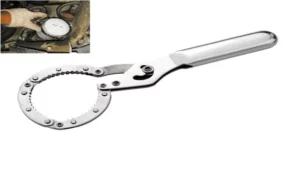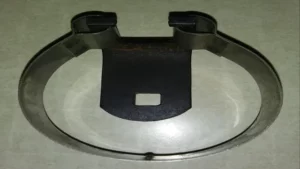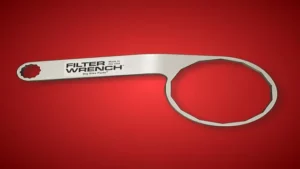Let’s face it, changing an oil filter is not the most enjoyable task for any auto enthusiast. But with the right tools, it can be a hassle-free process. One such tool is a swivel oil filter wrench, which makes removing and tightening the oil filter a breeze.
Not only does it save you time and effort, but it also ensures that the oil filter is tightened to the correct torque, preventing leaks and ensuring optimal performance. In this blog post, we’ll provide you with a comprehensive guide on how to use a swivel oil filter wrench, along with tips and tricks for extracting filters of any shape and size!
What is a Swivel Oil Filter Wrench?
If you want to change your car’s oil filter, then you should consider using a swivel oil filter wrench. This tool is designed to make the task easier and more efficient. With its built-in swivel feature, it can easily grip the oil filter and rotate it with ease, allowing you to remove it effortlessly.
To use this wrench, start by locating the oil filter and determining its size. Choose the swivel oil filter wrench that fits the filter. Then, position the wrench onto the filter and adjust it to ensure a tight grip.
Using this wrench, you can easily remove the filter, even if it’s stuck due to excessive pressure or residue buildup. The swivel feature of the wrench allows you to access hard-to-reach areas and angles, making it the perfect tool for DIY oil changes. So next time you are changing your car’s oil filter, remember to use a swivel oil filter wrench for the easiest and most efficient experience.
Definition and Purpose
A swivel oil filter wrench is a specially designed tool that helps automobile mechanics or DIY enthusiasts to remove and install oil filters with ease. It consists of a handle, a swivel joint, and an adjustable strap that wraps around the filter. The swivel joint allows the tool to adjust to any angle or position, making it easier to grip and turn the filter even in tight spaces or awkward angles.
The purpose of a swivel oil filter wrench is to eliminate the frustration and time-consuming struggle of removing an old filter that becomes slippery and stuck over time. With this tool, you can apply more torque and leverage while maintaining a secure grip, preventing the filter from slipping or breaking. Whether you change your oil at home or run an automotive service, a swivel oil filter wrench is a must-have tool that saves you time, effort, and money in the long run.
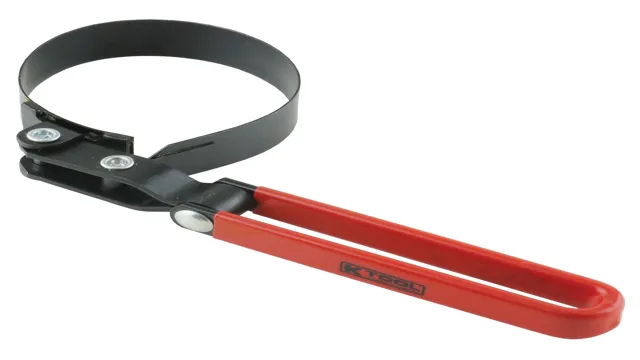
Steps to Follow
If you’re unfamiliar with using a swivel oil filter wrench, don’t worry, it’s easy and simple! First, locate the oil filter that needs to be removed. Then, select the correct size of swivel oil filter wrench and attach it securely to the filter. Make sure the wrench is adjusted to fit snugly around the filter to prevent slipping.
Once secured, rotate the wrench counterclockwise to loosen the filter. Be sure to catch any oil that may spill out when removing the filter. Once the filter is loose enough, remove it completely by hand and dispose of it properly.
To install a new oil filter, clean the area around the filter housing and apply a small amount of fresh oil to the gasket of the new filter. Then, screw the new filter into place, ensuring it is snug but not over-tightened. Using a swivel oil filter wrench can make this task much easier and efficient, so be sure to have one in your toolbox for your next oil change.
Step 1: Selecting the Correct Wrench Size
Choosing the correct wrench size is a crucial step in any repair or maintenance job. Using the wrong size can result in stripped bolts, damaged parts, and wasted time. To avoid such mishaps, you need to know exactly which size wrench to use.
The first step to selecting the correct wrench size is to identify the bolt or nut you need to turn. Once you have located it, you need to measure the width across its “flats,” or the six-sided shape that fits a wrench. You can do this by using a caliper or ruler to measure the distance between two opposite flat sides of the bolt or nut.
The measurement you get will correspond to a standard size in inches or millimeters, which you can then match to the corresponding wrench size. For example, if you measure 1 inch across the flats, then you will need a 1-inch wrench to turn the bolt. If you measure 12 millimeters across the flats, then you will need a 12mm wrench.
It is important to note that in some cases, the bolt or nut might not have a standard size, and you may need a specialized wrench or socket to turn it. Additionally, some bolts and nuts require a specific torque setting, so you will need a torque wrench to ensure you are applying the correct amount of force. Selecting the correct wrench size may seem like a small detail, but it can make a significant difference in the success of your repair or maintenance task.
Take the time to measure and match your wrench size, and you will save yourself from frustration, wasted time, and potentially costly damages.
Step 2: Placing the Wrench on the Oil Filter
When it’s time to change the oil filter, it’s essential to use the right tools. Placing the wrench on the oil filter is the second step in the process of changing the filter. To do this, you need to ensure that the wrench you are using is the right size for the filter.
Place the wrench onto the filter, making sure that it’s firmly in place. If the filter is tightly attached, you may need to use a little bit of force to loosen it. However, be careful not to use too much force as it could cause the filter to break, which could lead to a significant mess.
A good analogy for this process is that it’s like trying to unscrew a lid from a jar of peanut butter. Sometimes, it’s tightly sealed, and you need to use some force to open it. However, if you use too much force, the lid could pop off and cause a mess.
The same applies to the oil filter. Use the right amount of force to loosen it, but be careful not to use too much. In summary, when changing the oil filter, the second step is to place the wrench onto the filter.
Use the right size wrench and apply just enough force to loosen the filter without risking damage. By following these steps, you can successfully change your oil filter and keep your engine running smoothly.
Step 3: Adjusting the Swivel Joint of the Wrench
Adjusting the swivel joint of a wrench can be a little tricky, but it is an important step in ensuring you get the desired result. To start, you will need to locate the swivel joint and determine if there is any damage or wear. Once that is established, use a wrench to turn the swivel joint to the correct position.
It may take a few attempts to get it in the right position, but once it is aligned, you are ready to lock it into place. This is typically done by tightening a bolt or screw. It is important to ensure that the joint is locked tightly, but not too tight to prevent it from moving.
By adjusting the swivel joint, you will be able to get the angle you need to reach into tight spaces or awkward positions to complete your task. So, take the time to correctly adjust the swivel joint for the best results in your work.
Step 4: Turning the Wrench to Remove the Oil Filter
When it comes to removing an oil filter, there are several steps you need to follow to ensure you do it safely and properly. Once you have located the filter and chosen the right wrench, the next step is to turn the wrench and loosen the filter. It’s important to remember that some filters may be difficult to remove, so you may need to use some force.
However, don’t overdo it, as you do not want to damage the filter or its connections. One useful tip is to try using a rubber strap wrench or a pair of pliers to gain more leverage. Once the filter has been loosened, turn it slowly by hand until it comes off.
Be careful though, as there may be some oil left inside the filter, so make sure you have a catchment device or a rag handy to catch any spillages. By following these simple steps, you can safely remove your oil filter without causing any damage or mess.
Benefits of Using a Swivel Oil Filter Wrench
If you’re wondering how to use a swivel oil filter wrench, you’re in luck! This handy tool can make replacing your car’s oil filter a breeze. One of the biggest benefits of a swivel oil filter wrench is its ability to fit into tight spaces and adjust to the angle of the filter. This flexibility allows for increased torque and grip, resulting in easier removal of the filter.
Plus, the swivel design can help prevent damage to the filter and prevent leaks by ensuring a tight seal. Additionally, the wrench’s textured grip enhances your hold and control, regardless of the oil filter’s condition. So, if you want to simplify your next oil change and avoid frustration, consider investing in a swivel oil filter wrench.
Trust me; once you try it, you’ll wonder how you ever managed without it!
Easier Access to Hard-to-Reach Filters
If you’ve ever attempted to change your car’s oil filter yourself, you know how frustrating it can be to reach and loosen a hard-to-reach filter. Thankfully, the swivel oil filter wrench tool offers an innovative solution that can save you time and frustration. The tool is designed to easily swivel around the filter and provides a strong grip on the filter’s surface for easy removal.
This unique tool not only saves you time and frustration but also ensures that the filter is removed and replaced correctly, avoiding any unnecessary leaks or damage. Using a swivel oil filter wrench can be especially beneficial for DIY mechanics or those who frequently perform oil changes, as it cuts down on the amount of time and effort required for the job. With its ease of use and efficient design, a swivel oil filter wrench is a must-have tool for anyone who wants to simplify their oil changes and maintain their vehicle’s wellness.
Less Chance of Damaging the Filter or Other Car Parts
Swivel Oil Filter Wrench When it comes to changing your car’s oil filter, using a swivel oil filter wrench can make the process much easier, faster, and less damaging. The swivel feature of the tool allows you to grip the filter at the perfect angle and apply the right amount of pressure without having to contort your arm or twist your wrist, which could cause strain or injury. Additionally, the swivel oil filter wrench provides more torque, making it easier to turn the filter and remove it from the car.
By using this tool, you decrease the chances of damaging the filter or any other part of your car, such as the oil pan or the engine block. Plus, you save time and energy that you can use for other important car maintenance tasks. So why struggle with a traditional oil filter wrench when you can use a swivel oil filter wrench and change your car’s oil more efficiently and effectively? Try it out for yourself and see the difference firsthand.
Tips and Warnings
If you need to change your oil filter, you may want to consider using a swivel oil filter wrench. This tool can make removing and installing your oil filter easier and quicker than other methods. To use a swivel oil filter wrench, first, locate your oil filter and make sure you have the correct size wrench for it.
Then, wrap the wrench around the filter and turn it counterclockwise to loosen it. Once it’s loose, you can remove it by hand. When installing the new filter, make sure to lubricate the gasket with a small amount of oil before tightening it with the wrench.
However, it’s important to note that not all vehicles require a swivel oil filter wrench, so always refer to your owner’s manual to determine the best method for your specific vehicle. Using the wrong tool or method can cause damage to your vehicle or harm to yourself, so always follow the proper instructions and take necessary precautions when working on your car.
Tip 1: Using Gloves for Proper Grip
When it comes to working with your hands, having a proper grip on tools and equipment is essential for efficiency and safety. One simple way to improve your grip is by using gloves specifically designed for the task at hand. Not only do gloves provide added traction, but they also protect your hands from potential injuries.
However, it’s important to note that not all gloves are created equal. Depending on the job, different types of gloves may be necessary. For example, gloves with a textured surface may be better for working with oily or slippery objects, while gloves with a smooth surface may be better for handling delicate materials.
Additionally, it’s important to make sure that the gloves fit properly. Gloves that are too loose may actually hinder your grip and create a safety hazard. On the other hand, gloves that are too tight can restrict movement and cause discomfort.
Always choose gloves that are designed for the specific job and make sure they fit properly before getting to work.
Tip 2: Cleaning the Wrench After Use
After using a wrench, it’s important to clean it properly so that it can perform well in future uses. To clean it, first, wipe it using a dry rag to remove dust particles. Next, use a metal brush to remove any rust or debris that has accumulated on the wrench.
For tougher grime, you can use a cleaning solution made from equal parts of water and vinegar. Dip the wrench into this solution for a few minutes before using a soft brush to scrub it and rinse it under running water. Afterward, make sure to dry the wrench to prevent rusting.
By cleaning your wrench regularly, you’ll be able to keep it in good condition and extend its lifespan. However, always remember to wear gloves and safety goggles when using cleaning solutions to protect yourself from any chemical reactions that may occur.
Warning 1: Do not Use Too Much Force
If you’re looking to get started on a DIY home improvement project, it’s important to keep in mind that rushing things can often lead to disastrous results. When it comes to using tools and equipment, it’s crucial that you don’t use too much force, as this can cause irreparable damage to whatever you’re working on. Be patient and take your time, using just enough pressure to get the job done.
If you’re unsure about how much force to use, take a step back and assess the situation before proceeding. Remember, when it comes to DIY projects, slow and steady wins the race. By taking a measured approach and using the right tools for the job, you’ll save yourself time, money, and needless stress.
So, whatever you do, don’t rush it!
Warning 2: Do not Use on Hot Engine or Filter
If you’re planning to change your car’s oil or air filter, make sure your engine is completely cool before starting the process. Using oil or filter on a hot engine can cause the liquid to evaporate quickly, making it challenging to control the mess. Moreover, you may end up causing some serious damage to your vehicle, which may entail expensive repairs and replacements.
Always remember that prevention is better than cure. It is best to let your engine cool down for at least 30 minutes before commencing work. Also, never attempt any maintenance work if you’re feeling tired or drowsy.
Doing so can compromise your judgement and increase the chances of accidents. Be cautious and make sure you have all the tools you’d need before starting anything. Take note of these essential reminders, and you’ll have a smooth and safe DIY experience.
😊
Warning 3: Do not Use on Oil Filter with Plastic Housing
When it comes to changing the oil filter in your car, it’s important to know the type of filter your vehicle uses. Some filters have a plastic housing, which require certain precautions when changing them. A common mistake people make is using the wrong tool or excessive force to loosen the filter, which can crack or damage the plastic housing.
This can result in oil leakage or even more expensive repairs. To avoid this issue, it’s important to read the manufacturer’s instructions beforehand and use the correct tool for the job. If you’re unsure about how to proceed, it’s best to bring your car to a professional service center where they can safely change the filter for you without risking any damage.
Remember, taking precautions and being aware of your vehicle’s specific needs can save you time and money in the long run.
Conclusion
Now that you know how to use a swivel oil filter wrench, you can turn that frustration into satisfaction when changing your oil. Just remember to securely fasten the wrench onto the oil filter, apply a firm grip, and let the swivel do the work for you. And if anyone asks how you managed to change your oil with such ease, just tell them you had a clever little swivel working its magic.
Happy wrenching!”
FAQs
What is a swivel oil filter wrench?
A swivel oil filter wrench is a tool that is designed to make removing and installing oil filter easier, by allowing you to maneuver the tool around obstacles and get better grip on the filter.
Can I use a swivel oil filter wrench on any type of oil filter?
Yes, you can use a swivel oil filter wrench on any type of oil filter, as long as it is the correct size and type of wrench for the filter.
How do I choose the right size swivel oil filter wrench?
To choose the right size swivel oil filter wrench, you should measure the diameter of your oil filter and select a wrench that fits that size.
Is it easy to use a swivel oil filter wrench?
Yes, swivel oil filter wrenches are generally very easy to use, as they are designed to provide a good grip on the filter without slipping or damaging it.
Can a swivel oil filter wrench be used on a hot engine?
Yes, a swivel oil filter wrench can be used on a hot engine, but you should be careful not to touch the engine or other hot parts of the vehicle with the tool.
How do I maintain my swivel oil filter wrench?
To maintain your swivel oil filter wrench, you should clean it after each use and store it in a safe place away from moisture and other contaminants.
Where can I buy a swivel oil filter wrench?
Swivel oil filter wrenches can be purchased at most automotive supply stores, online retailers, and some hardware stores.
